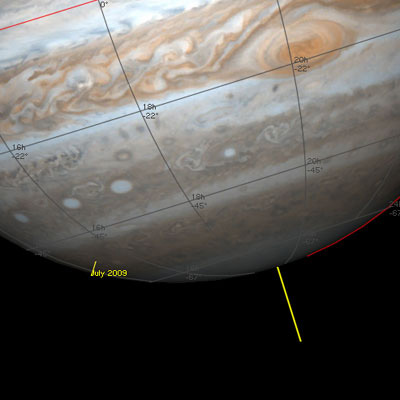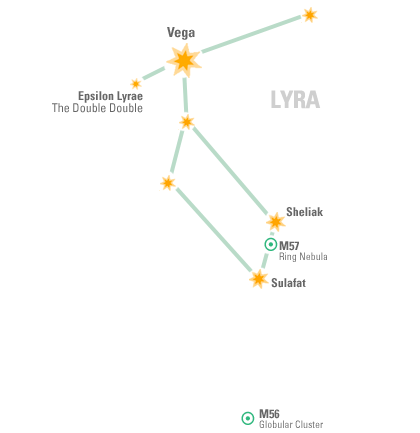|
If you have trouble viewing this newsletter, click here.
For education orders please call 1-877-290-8256.
Welcome again to our monthly educational newsletter with features on exciting celestial events, product reviews, tips & tricks, and a monthly sky calendar. We hope you enjoy it!

Users of Starry Night Pro Plus, Pro, Enthusiast and Complete Space & Astronomy Pack can now update to version 6.3.3.
Click the following link to read about enhancements and bug fixes in this free update:
Updaters can be downloaded from:
[Top of Page]

On July 19th, Australian amateur astronomer Anthony Wesley discovered a curious new feature near Jupiter's south pole – a big black spot reminiscent of the scars left by the impacts of Comet Shoemaker-Levy 9.
Sure enough, NASA scientists following up on Wesley's observations are confident that this new marking was indeed created by an impacting object.
You can see the discovery images here:
Article and infrared observations from JPL are here:
Shoemaker-Levy 9 (or SL-9) was discovered in 1993 when it swung past Jupiter, and the big planet's gravity broke it up into a train of smaller comets. All eyes were on Jupiter in 1994 as they returned and smacked into Jupiter's atmosphere one at a time, leaving temporary black scars just like the one seen this week.
An archive of images and related articles about SL-9 can be found here:
SL-9 was the first confirmed observation of a collision between solar system bodies, but the results of such collisions have been observed before. Here's a link to a paper describing historical observations of spots on Jupiter, including observations by Giovanni Cassini, Robert Hooke, and William Herschel.
We've seen this happen before, but until SL-9 we weren't entirely sure what the marks were. Now we know because we've seen it happen, and in July of 2009 we saw the results of another such incident.
Finally, a clarification – you may have heard that the object that hit Jupiter was the size of the Earth. The misconception probably comes from the fact that the impact scar itself is Earth-sized. The object that made it, on the other hand, would have been much smaller than the Earth. For comparison, the largest fragments of SL-9 were only a few kilometres across (about the size of a large town!), and left scars of a similar size to the one seen this week.
If you want to try observing the spot yourself, you can download this file to mark its location on Jupiter in Starry Night.
Brenda Shaw
[Top of Page]

One of the most useful features in Starry Night is the Find pane. This can be accessed in two ways:
- by clicking the Find tab on the left side of the screen;
- by pressing command-F on the Mac or control-F on Windows.
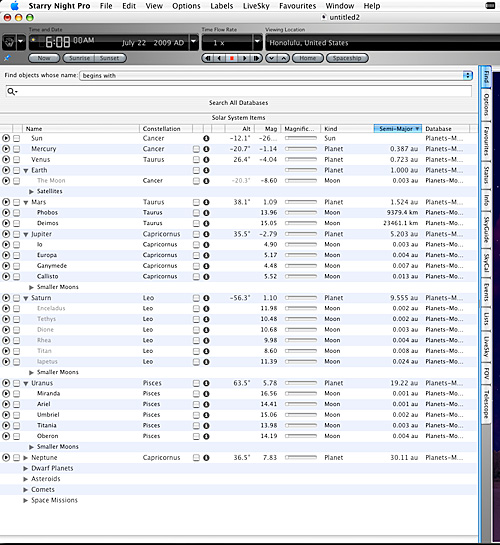
Normally only the left side of the Find Pane displays, but by dragging its right border, you can expand it as shown above, displaying a number of additional columns.
Starry Night contains a huge database of objects. If you type in an object name and hit Return, Starry Night will locate your object. However, because Starry Night contains millions of objects in its database, you can search quicker by selecting what database to search. There are two ways of limiting Starry Night’s search:
1) Use the drop-down menu at the top of the Find Pane to tell it what part of the name to search for:
- begins with
- is exactly
- contains
- ends with
2) Click on the magnifying glass to select the database in which to search:
- Meteor Showers
- Orbiting Objects
- Constellation
- Messier Objects
- etc.
By setting these limits before you begin to enter the search term, you will speed up the search so that it’s almost instantaneous. By default, Starry Night displays Orbiting Objects, but, as soon as you select a database, it then displays that database.
What are all those columns?
Let’s go through them one by one, as they all do useful things.
- Contextual Popup. This triggers a pop-up menu that lets you do many things to the object. This is the same menu you see when you control-click on an object.
- Selection Checkbox. This lets you select the object. This puts a label on the object and puts it in the Info Pane.
- Name. If grayed out, object is below horizon.
- Constellation.
- Orbit Checkbox. Turns the object’s orbital line on and off.
- Info. Brings up the Info Pane.
- Log Entries. Indicates if there are log entries for this object.
- Altitude. In degrees above the horizon, negative if below the horizon.
- Magnitude.
- Magnification. This is a slider which lets you selectively magnify the particular object, while leaving everything else its normal size.
- Kind.
- Semi-Major Axis. Average distance from primary.
- Database. Tells you which database the object is in. Some are in more than one database, so have multiple listings in the Find Pane.
As if these weren’t enough, you can add a number of additional columns by control clicking on the column headings: Local Path, Hide, Celestial Path, Azimuth, Angular Size, Rise, Transit, Set, Right Ascension, Declination, Percent Illumination, and Distance.
You can also perform standard database procedures, like sorting by clicking in the column header. If you don’t like the order of the columns, you can drag the column headings to change their order. You can also remove any column the same way.
A final tip
One final tip, which a lot of people miss. How do you get Starry Night to point at something which is not in any of its databases? Very simple: Under the Edit menu, choose Centre On… Click on the coordinate system you wish to use; in most cases this is “Equatorial J2000,” the equatorial coordinates for Epoch 2000.0. Enter the right ascension and declination using the syntax shown, and Starry Night will center on these coordinates.
Geoff Gaherty
Geoff has been a life-long telescope addict, and is active in many areas of visual observation; he is a moderator of the Yahoo "Talking Telescopes" group.
[Top of Page]

CoalSack Nebula
The Coalsack is the sky’s most prominent dark nebula, visible to the naked eye as a dark region void of stars that obscures 26 square degrees of sky. Dark nebulae are clouds of dust and gas that block light from background stars. Sweeping the Coalsack area with binoculars is a delight, especially when you contrast it with the bright Jewel Box cluster lurking just to the north. The contrast with the bright Southern Milky Way makes the CoalSack look darker than any other part of the sky. The aboriginal Australians saw the Coalsack as the head of a giant emu.
Pedro Braganca
Education & Content Director
Starry Night® Education
[Top of Page]

Lyra is currently well placed for observation. Overhead during and after dusk, it passes through the zenith around midnight.
Vega is the northern hemispehere's second brightest star; only Sirius, at a magnitude of -1.5, is brighter. Because the Earth's spin is slightly imperfect, its axis carves a circle on the sky every 26,000 years. The phenomenon, called precession, means that as time progresses each pole, north and south, points to different stars. 13,000 years ago, Lyra was directly above our north pole and therefore acted as our Pole Star. And in another 13,000 years or so, it will once again act in that capacity.
One of the best known planetary nebulas is M57, lying roughly half way between Sheliak and Sulafat. Its cosmic bagel structure is apparent even in a 3" scope and, with larger apertures, only becomes clearer and more detailed. Try several levels of magnification.
M56 is a fairly dispersed globular cluster.
Finally, Epsilon Lyrae is one of the most beloved double star systems. It's fairly easy to split the first double, but higher magnification reveals that each component is itself a binary system.
Sean O'Dwyer
Starry Night® Times Editor
[Top of Page]

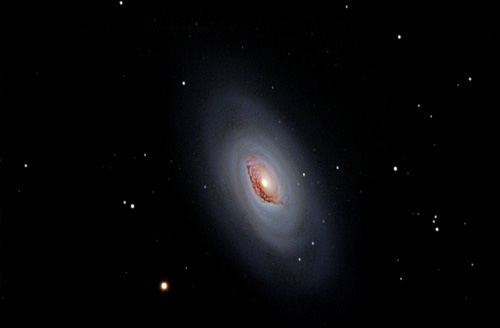
Black Eye Galaxy (M64) by Bareket Observatory, Israel.
RULES:
We would like to invite all Starry Night® Education users to send their quality astronomy photographs to be considered for use in our monthly newsletter. Please read the following guidelines and see the submission e-mail address below.
- Format: Digital images in either JPG, GIF or TIFF format.
- Size: 700 pixels wide maximum.
- File size should be less than 2 MB.
- Include a caption: Your full name, location where photo was taken and any interesting details regarding your photo or how you took it. Please be brief.
- Important notes: We may edit captions for clarity and brevity. We reserve the right to not use submissions. In submitting your image or images to Simulation Curriculum, you agree to allow us to publish them in all media—on the Web or otherwise—now and in the future. We'll credit you, of course. Most important, you'll have the satisfaction of sharing your experience with the world!
- Send images, following the above guidelines, to photo@starrynight.com (by sending an image you agree to the above terms, including Simulation Curriculum’s right to publish your photos). Please do not send .ZIP files as they will not reach us.
[Top of Page]
|
 |
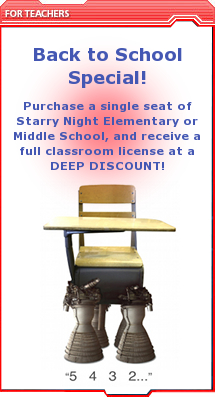 |
 |
 |
 |
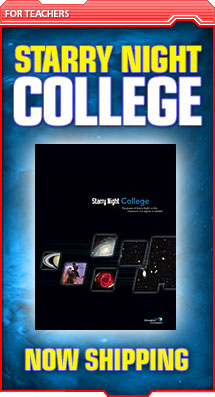 |
 |
 |
 |
 |
 |
Starry Night® Podium User’s Guide
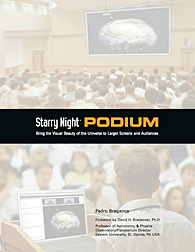
Learn more about Starry Night Podium by downloading the Starry Night Podium User’s Guide. If you lecture to larger audiences, Starry Night Podium will revolutionize your astronomy teaching and energize your students.
|
 |
 |
Contact Us to learn more about Starry Night Podium.
Pedro Braganca
Education & Content Director
Starry Night® Education
|
 |
 |
 |
 |
 |
 |
 |
Free Resources
We’ve added a number of free resources to our Web site. Additions include concept diagrams, panoramas, tutorials and even a digital copy of an introductory book on astronomy. Enjoy.
Pedro Braganca
Education & Content Director
Starry Night® Education
|
 |
 |
 |
 |
 |
 |
 |
Follow us at
• twitter.com/starrynightedu
|
 |
 |
 |
 |
 |
 |
 |
Moon Phases
 Wed., August 5 Wed., August 5
Full Moon, 8:55 p.m.
The Full Moon of August – that is, the eighth of the year – is known as the Grain Moon. To Native Americans it was called the Sturgeon Moon. Other names are Red Moon, Green Corn Moon, Lightning Moon, and Dog Moon. In Hindi it is known as Narali Poornima or Raksha bandhan.
 Thu., August 13 Thu., August 13
Last Quarter Moon, 2:55 p.m.
The Last or Third Quarter Moon rises at roughly midnight, but is still high in the southern sky long after sunrise. If you can view the Moon several mornings in a row, note the subtle change in its shape.
 Thu., August 20 Thu., August 20
New Moon, 6:02 a.m.
The thin Crescent Moon over the past few mornings has thinned to invisibility; so don't bother trying to observe this. However, there is a very slight chance of catching a razor thin Moon a few degrees above the western horizon 20-30 minutes after sunset on Friday. It should be easier to find on Friday evening.
 Thu., August 27 Thu., August 27
First Quarter Moon, 7:42 a.m.
The First Quarter Moon rides high in the southern sky at sunset, and sets around midnight.
Observing Highlights
Wed., August 12
Perseid meteors peak, 2 p.m.
For many people, the Perseid meteor shower in August is the highlight of the year. This is the richest and broadest meteor shower of the entire year, lasting a couple of weeks and rewarding observers with multiple bright meteors every night. You will always see more meteors from a dark site after midnight, but it’s hard to miss a meteor if you spend any time watching the sky during this period. This year a bright Last Quarter Moon rises around midnight, cutting down the number of meteors you will see.
Wed./Thu., August 26/27
Quadruple Jupiter transit, 10:41 p.m.-12:35 a.m.
Jupiter is just past opposition, so that its moons and their shadows are very close together. This makes it possible for both the moon and its shadow to be in transit across the planet’s face at the same time. Tonight there’s a “double feature”: both Europa and Ganymede are in transit, as are their shadows, so that for nearly two hours all four will be in view simultaneously. Any telescope over 90mm aperture should show the shadows, and a 125mm telescope should show Ganymede as a grey disk. Europa usually disappears into the camouflage of Jupiter’s cloud tops, and requires quite a large telescope to be seen.
Planets
Mercury is well placed in the evening sky for observers in the Southern Hemisphere for most of the month, but less well for observers in the Northern Hemisphere.
Venus continues to dominate the pre-dawn sky, shining with a magnitude of -4.
Mars continues to be paired with Venus for the whole month, but gradually they are drawing apart. Venus, as always, is tethered to the Sun, while Mars is moving slowly towards opposition with the Sun on January 29, 2010.
Jupiter is in opposition on August 14, and visible all night long in the southern sky. There will be several spectacular transits of its moons and their shadows this month.
Saturn is low in the western sky all month, and quite dim because its rings are nearly edge on to Earth, and not reflecting back any sunlight.
Dates
Fri., August 14
The Moon and the Pleiades, 5 a.m.
This is an event worth getting up early to see. The Moon will be almost directly in front of the brilliant star cluster, the Pleiades.
Mon., August 17
The Moon and Venus, 11 a.m.
Here’s an opportunity to easily observe the planet Venus in full daylight. At 11 a.m. the crescent Moon will be right on the meridian, high in the south, and the planet Venus will be only 4 degrees away from it, to the lower left. You should be easily able to see Venus in binoculars next to the Moon and, once you’ve got it located, you should also be able to see it with your naked eye.
As always, there's more to explore on NightSky.
Data for this calendar have been derived from a number of sources including the Observer's Handbook 2009 of the Royal Astronomical Society of Canada, Starry Night® software, and others. Only events with a reasonable possibility for Northern Hemisphere observers, or those events with some other significance, are given. All times shown are U.S. Eastern Time.
|
 |
 |
 |
 |
 |
 |
 |
Prepare Your Students for NCLB Science Testing
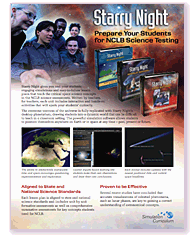
Starry Night® gives you and your students engaging stimulations and easy-to-follow lesson plans that teach the critical space science concepts in the NCLB science assessments.
Written by teachers, for teachers, each unit includes interactive and hands-on activities that will spark your students' curiosity.
Click here to download full brochure.
|
 |
 |
 |
 |
 |
 |
 |
California Science Teachers Association Conference
October 22-25, 2009: Palm Springs, CA
National Science Teachers Association Regional Conference
October 29–31, 2009: Minneapolis, MN
Science Teachers Association of Texas Conference
November 4-7, 2009: Galveston, TX
National Science Teachers Association Regional Conference
November 12–14, 2009: Fort Lauderdale, FL
Science Teachers Association of Ontario Conference
November 12-14, 2009: Toronto, ON
National Science Teachers Association Regional Conference
December 3–5, 2009: Phoenix, AZ
|
 |
 |
 |
 |
 |
 |
 |
Educational Inquiries and Sales
Please contact Michael Goodman for all education inquiries. EDUCATION ORDERS 1-877-290-8256
|
 |
 |
 |
 |
 |
 |
 |
Send us your feedback
Do you have a question, comment, suggestion or article idea to pass along to Starry Night® Times?
Click here to get in touch with us.
|
 |
 |
 |
 |
 |
 |
 |
Starry Night® is the world's leading line of educational astronomy software and DVDs. Visit starrynighteducation.com to see all the great products we offer for everyone from novice to experienced astronomers.
You have received this e-mail as a trial user of Starry Night® Digital Download or as a registrant at starrynight.com.
To unsubscribe click here.
To subscribe sign up here.
Starry Night® is a division of Simulation Curriculum Corp.
Simulation Curriculum Corp.
Starry Night® Education
5666 Lincoln Drive, Suite 260
Edina, MN 55436
Tel: (877) 290-8256
|
 |
 |
|


